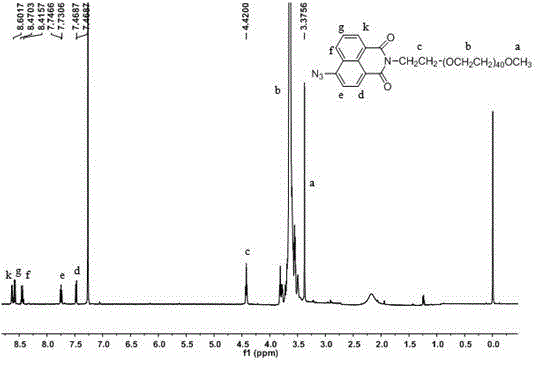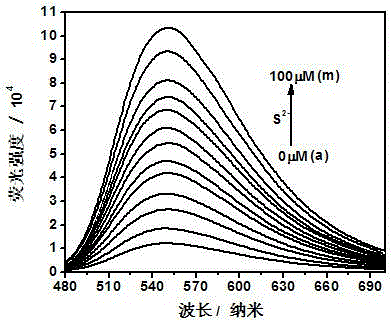Sulfion sensor based on polyethylene glycol and preparation method and application thereof
A polyethylene glycol and sulfur ion technology, applied in the fields of life science, environmental science, and analytical chemistry, can solve the problems of high cost input and complicated detection process, and achieve the effects of low cost input, simple synthesis route and convenient post-processing.
- Summary
- Abstract
- Description
- Claims
- Application Information
AI Technical Summary
Problems solved by technology
Method used
Image
Examples
Embodiment 1
[0024] A method for preparing a fluorescent sensor with a sulfide ion detection function, comprising the following steps:
[0025] (1) Dissolve monoamino polyethylene glycol with a molecular weight of 1000 and 4-bromo-1,8-naphthalene anhydride in a molar ratio of 1:2 in absolute ethanol, and place in N 2 Under the condition of protecting and avoiding light, after 30~45 minutes, continue to heat up to 85°C and stir and reflux for 20 hours. After the reaction is completed, filter, and then remove a small part (10~30%) of absolute ethanol, recrystallize and precipitate the product, and filter with suction The desired product was obtained and dried in vacuum to obtain polyethylene glycol-modified 4-bromo-1,8-naphthalene anhydride;
[0026] (2) Take the polyethylene glycol-modified 4-bromo-1,8-naphthalene anhydride synthesized in step (1) and sodium azide in a molar ratio of 1:5, and dissolve it in N,N-dimethylformamide , put the mixed solution in the dark and N 2 Stir at 85°C...
Embodiment 2
[0028] A method for preparing a fluorescent sensor with a sulfide ion detection function, comprising the following steps:
[0029] (1) Dissolve monoaminopolyethylene glycol with a molecular weight of 2000 and 4-bromo-1,8-naphthalene anhydride in a molar ratio of 1:8 in absolute ethanol, and place in N 2 Under the condition of protecting and avoiding light, after 30~45 minutes, continue to heat up to 85°C and stir and reflux for 20 hours. After the reaction is completed, filter, and then remove a small part (10~30%) of absolute ethanol, recrystallize and precipitate the product, and filter with suction The desired product was obtained and dried in vacuum to obtain polyethylene glycol-modified 4-bromo-1,8-naphthalene anhydride;
[0030] (2) Take the polyethylene glycol-modified 4-bromo-1,8-naphthalene anhydride and sodium azide synthesized in step (1) at a molar ratio of 1:10, and dissolve it in N,N-dimethylformamide , put the mixed solution in the dark and N 2 Stir at 85°C fo...
Embodiment 3
[0032] A method for preparing a fluorescent sensor with a sulfide ion detection function, comprising the following steps:
[0033] (1) Dissolve monoaminopolyethylene glycol with a molecular weight of 2000 and 4-bromo-1,8-naphthalene anhydride at a molar ratio of 1:20 in absolute ethanol, and place in N 2 Under the condition of protecting and avoiding light, after 30~45 minutes, continue to heat up to 85°C and stir and reflux for 20 hours. After the reaction is completed, filter, and then remove a small part (10~30%) of absolute ethanol, recrystallize and precipitate the product, and filter with suction The desired product was obtained and dried in vacuum to obtain polyethylene glycol-modified 4-bromo-1,8-naphthalene anhydride;
[0034] (2) Take the polyethylene glycol-modified 4-bromo-1,8-naphthalene anhydride and sodium azide synthesized in step (1) at a molar ratio of 1:25, and dissolve it in N,N-dimethylformamide , put the mixed solution in the dark and N 2 Stir at 85°C f...
PUM
 Login to View More
Login to View More Abstract
Description
Claims
Application Information
 Login to View More
Login to View More - R&D
- Intellectual Property
- Life Sciences
- Materials
- Tech Scout
- Unparalleled Data Quality
- Higher Quality Content
- 60% Fewer Hallucinations
Browse by: Latest US Patents, China's latest patents, Technical Efficacy Thesaurus, Application Domain, Technology Topic, Popular Technical Reports.
© 2025 PatSnap. All rights reserved.Legal|Privacy policy|Modern Slavery Act Transparency Statement|Sitemap|About US| Contact US: help@patsnap.com



